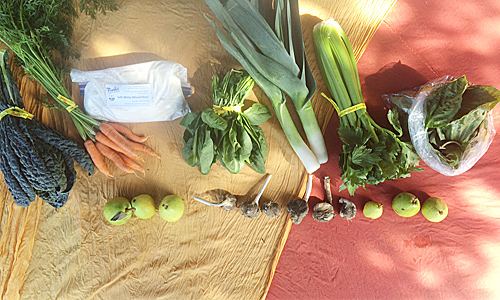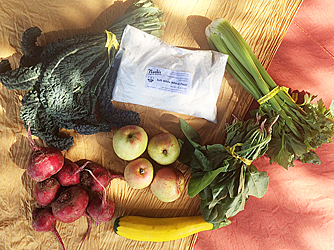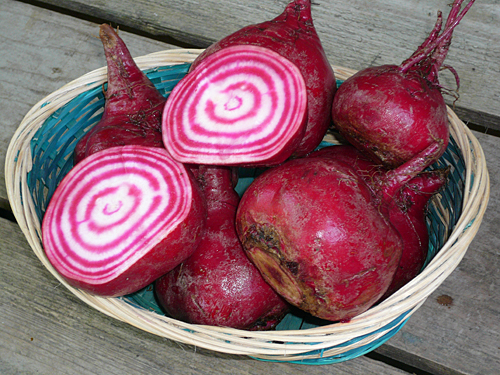
In the Standard Box:
Soft White Wheat Flour 2 lb
Garlic 1/2 lb
Bunched Carrots 1 bu
Spinach 1 bu
Leeks 2
Lacinato Kale 1 bu
Pears 1.5 lb
Basil 1/4 lb
Celery 1 hd

In the Small Box:
Soft White Wheat Flour 2 lb
Spinach 1 bu
Chioggia Beets 2 lb
Lacinato Kale 1 bu
Apples 1.5 lb
Yellow Zucchini or Leek 1 ea
Celery 1 hd
Lacinato Kale
Lacinato kale has a long tradition in Italian cuisine, especially in Tuscany. Consequently, it is also known as Tuscan kale, Tuscan cabbage, Italian kale, dinosaur kale, black kale, flat-back cabbage, palm tree kale, or black Tuscan palm. It has been grown in Tuscany for centuries, and is one of the traditional ingredients of minestrone. Its taste is described as slightly sweeter and more delicate than curly kale.
Lacinato’s flavor can stand up to even anchovies, and it is paired with them in some Italian dishes. It is commonly used in pastas and soups, but can also be eaten raw, or chopped fine in a salad.
This nutrient power house is high in vitamins A and C, as well as calcium, iron, and manganese. It is also rich in easily digestible dietary fiber and is the superstar of carotenoids and flavonoids which are two powerful antioxidant types that protect our cells from free radicals (there are 45 distinct flavonoids in kale!) It also provides a whopping dose of vitamin K, needed to strengthen our bones—132%—and is also a rich source of easily digestible dietary fiber.
Lemony Braised Lacinato Kale
1 large bunch (about 10 ounces) Lacinato Kale, leaves rinsed and thick center ribs cut out
Scant 1/2 Tbsp. extra-virgin fruity olive oil
2 to 4 garlic cloves, or to taste
1/8 cup dry white wine (could use vermouth)
1/4 to 1/2 cup chicken stock
1 tsp. coarse salt or sea salt
1 to 2 tsp. freshly-squeezed lemon juice, to taste
Cut kale into 1” pieces and steam until slightly wilted. Remove from heat and drain well.
In a large fry pan over low heat, heat olive oil. Add garlic and sauté, stirring often, until soft. Add kale and wine; cover and cook until almost all liquid has evaporated. Add 1/4 cup chicken stock and cook until stock is almost evaporated and kale is very tender, approximately 30 minutes. Check for tenderness. If needed, add the remainder of the chicken stock and cook until done.
Season to taste with salt and lemon juice; toss with tongs and serve. Serves 2.
Chioggia/Apple Salad
1 bunch of Chioggia beets
2 medium size apples
1 handful of mixed salad leaves
⅓ c. fresh basil
Zest of 1 lime
Dressing
½ c. goat cheese
1 tbsp. fresh lime juice
2 tbsp. milk
1 tbsp. olive oil
1 tsp. honey
Zest your lime and reserve it for the salad.
Blitz all of the salad dressing ingredients in a mini food processor (you can also do this by hand with a whisk and room temperature goat cheese). Season with salt and pepper to taste. The flavor should be tangy with a hint of sweetness.
Trim and peel the beets with a vegetable peeler. If the tops look good, wash them and save for stir frys and salads. Thinly slice beets with a mandolin.
Thinly slice your apples and keep them stacked. Cut vertically into matchsticks.
Place beets and apples in a bowl. Add a little dressing and season with salt and pepper. Let it sit for 10 minutes or so to soften.
Tear up the basil leaves. Add them and salad leaves to the bowl. Give it a good toss and taste to see if it needs more seasoning or dressing. Evenly sprinkle the lime zest on top and serve immediately.
Refrigerate any extra goat cheese dressing in an airtight container for about a week.

Chioggia beets have those beautiful concentric circles that add to the look of the recipe. We thank www.theclevercarrot.com for it.
Nash’s soft white wheat flour is a whole grain product, so when we grind the wheat seeds, all parts of the seed including the bran (which contains fiber), the germ (which contains valuable oils and nutrients) and the endosperm are all still there, creating a nourishing end product. At Nash’s, we grow and mill the grains at the farm, delivering a fresh product with a difference you can taste. Our soft white wheat flour is perfect for making pastries, cakes, cookies, cereals, flat breads and crackers. Our flour is a living product. To maintain its freshness, we recommend storing it in the refrigerator or freezer.
